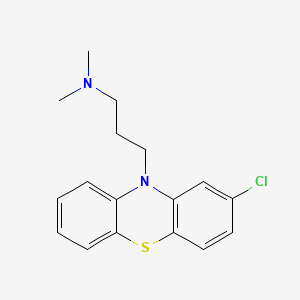m6A-centered Drug Response Information
General Information of the Drug (ID: M6APDG01304)
| Name |
Chlorpromazine
|
||||
|---|---|---|---|---|---|
| Synonyms |
10-(3-Dimethylaminopropyl)-2-chlorophenothiazine; 10H-Phenothiazine-10-propanamine, 2-chloro-N,N-dimethyl-, radical ion(1+); 2-Chloro-10-(3-(dimethylamino)propyl)phenothiazine; 2-Chloro-10-[3-(dimethylamino)propyl]phenothiazine; 2-Chloropromazine; 2-Cloro-10 (3-dimetilaminopropil)fenotiazina; 2-Cloro-10 (3-dimetilaminopropil)fenotiazina [Italian]; 2-chloro-10-(3-(dimethylamino)propyl)-phenothiazine; 2-chloro-N,N-dimethyl-10H-Phenothiazine-10-propanamine; 3-(2-Chloro-10H-phenothiazin-10-yl)-N,N-dimethyl-1-propanamine; 3-(2-chloro-10H-phenothiazin-10-yl)-N,N-dimethylpropan-1-amine; 3-(2-chlorophenothiazin-10-yl)-N,N-dimethyl-propan-1-amine; 3-(2-chlorophenothiazin-10-yl)-N,N-dimethylpropan-1-amine; Aminasine; Aminazin; Aminazine; Ampliactil; Amplicitil; Amplictil; BC 135; Chlor-PZ; Chlor-Promanyl; Chlordelazine; Chlorderazin; Chloro-3 (dimethylamino-3 propyl)-10 phenothiazine; Chloro-3 (dimethylamino-3 propyl)-10 phenothiazine [French]; Chloropromazine; Chlorpromados; Chlorpromanyl (discontinued); Chlorpromazin; Chlorpromazine (USP/INN); Chlorpromazine Tannate; Chlorpromazine [USAN:INN:BAN]; Chlorpromazinum; Chlorpromazinum [INN-Latin]; Clorpromazina; Clorpromazina [INN-Spanish]; Clorpromazina [Italian]; Contomin; Cromedazine; Elmarin; Esmind; Fenactil; Fenaktyl; Fraction AB; HL 5746; JHICC02042; Largactil; Largactil (TN); Largactil Liquid; Largactil Oral Drops; Largactilothiazine; Largactyl; Megaphen; N-(3-Dimethylaminopropyl)-3-chlorophenothiazine; Novo-Chlorpromazine; Novomazina; Phenactyl; Phenathyl; Phenothiazine hydrochloride; Plegomasine; Plegomazin; Prazilpromactil; Proma; Promactil; Promazil; Propaphen; Propaphenin; Prozil; Psychozine; SKF 2601-A; SKF 2601A; SKF-2601; Sanopron; Thorazine; Thorazine (TN); Thorazine Spansule; Thorazine Suppositories; Thorazine hydrochloride; Torazina; Wintermin; Z80; [3-(2-Chloro-phenothiazin-10-yl)-propyl]-dimethyl-amine
Click to Show/Hide
|
||||
| Status |
Approved
|
||||
| Structure |
 |
||||
| Formula |
C17H19ClN2S
|
||||
| InChI |
1S/C17H19ClN2S/c1-19(2)10-5-11-20-14-6-3-4-7-16(14)21-17-9-8-13(18)12-15(17)20/h3-4,6-9,12H,5,10-11H2,1-2H3
|
||||
| InChIKey |
ZPEIMTDSQAKGNT-UHFFFAOYSA-N
|
||||
| PubChem CID | |||||
| VARIDT Drug ID | |||||
Target Gene(s) and Their Upstream m6A Regulator, Together with the Effect of Target Gene(s) in Drug Response
The target genes involved in drug-target interaction (such as drug-metabolizing enzymes, drug transporters and therapeutic targets) and drug-mediated cell death signaling (including modulating DNA damage and repair capacity, escaping from drug-induced apoptosis, autophagy, cellular metabolic reprogramming, oncogenic bypass signaling, cell microenvironment, cell stemness, etc.) could be regulated by m6A regulator(s) and affected their corresponding drug response. You can browse detailed information on drug-related target gene(s) mediated by m6A regulators.
P-glycoprotein 1 (ABCB1)
Insulin-like growth factor 2 mRNA-binding protein 3 (IGF2BP3)
| In total 1 mechanisms lead to this potential drug response | ||||
| Response Summary | P-glycoprotein 1 (ABCB1) is a therapeutic target for Chlorpromazine. The Insulin-like growth factor 2 mRNA-binding protein 3 (IGF2BP3) has potential in affecting the response of Chlorpromazine through regulating the expression of P-glycoprotein 1 (ABCB1). | [1], [2] | ||
Methyltransferase-like 3 (METTL3)
| In total 1 mechanisms lead to this potential drug response | ||||
| Response Summary | P-glycoprotein 1 (ABCB1) is a therapeutic target for Chlorpromazine. The Methyltransferase-like 3 (METTL3) has potential in affecting the response of Chlorpromazine through regulating the expression of P-glycoprotein 1 (ABCB1). | [2], [3] | ||
References